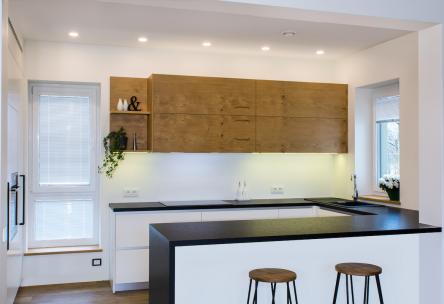Reduce the risk of kitchen injuries by making a few practical changes

The kitchen is the heart of your home. So it makes sense that it should be comfortable, even when you’re loading the dishwasher, tending to bubbling pots on all four burners, or working on a laptop at your breakfast table. We may not think of kitchens as adaptable spaces, but why not? “Ergonomics is all about suiting the environment to you, rather than changing yourself to the environment,” says physical therapist Mary-Catherine Fraser Saxena, clinic director of Toronto-based fitness club Totum Life Science. Whether you’re a cook-every-meal-from-scratch person or you enjoy the convenience of ordering in, these seven tweaks to your kitchen setup can make the space better suited your physical needs.
- Counters: The standard counter height is 36 inches (with countertop), according to the American National Standards Institute/Kitchen Manufacturers of America but that may not be comfortable for those who are significantly taller or shorter than average. If that’s you, and you’re planning to renovate, you can customize your counter height, says Fraser Saxena—but discuss it with an architect or designer first, and test out some sample heights. If you’re not doing a renovation, you can shift your counter height manually: For taller cooks, stack a couple of heavy cutting boards on the counter to shorten the distance, she recommends. If you’re shorter, use a stable stepstool for small tasks.
- Chairs/stools: To promote the most upright posture, allow about 12 inches of space from the bottom of a table, kitchen island, or countertop to the top of the barstools or chairs, says New York City home designer Allison Tick. If you’re taller or shorter than average, you may want to consider custom-size chairs or stools, Fraser Saxena says, and if you’re shorter, consider adding a footrest underneath your seats. When sitting at a dining table or for longer durations of time, use a chair with a back.
- Foot support: If you are standing in your kitchen for a long time, put on thick slippers or supportive shoes, Fraser Saxena says. And if you do a lot of meal prep at the kitchen sink, you might want to add a floor pad there for extra support, Tick recommends.
- Work triangle: This concept is employed by architects and designers to create the most efficient kitchen layout. Since most tasks performed in the kitchen involve the stovetop, refrigerator, or sink, the idea is that they should be arranged in an invisible triangle for maximum functionality. The recommended total length between the three areas is 25 feet, says Tick, with the maximum length of each leg being no more than three feet longer than either of the other two. This helps to minimize the distances you’re transporting hot or heavy pans, which reduces the risk of back strain or burning injuries. The triangle distance rule has loosened recently due to newer, more open kitchen designs, so discuss your individual specs with an architect or designer, if you’re renovating.
- Kitchenware placement: If possible, store the items that you use most frequently (dishes, glasses, utensils, everyday cooking items) at arm level. This will help you avoid straining your neck or back when you reach up or bend down to retrieve them. Store your dishes as close to the same level as your dishwasher as possible, for ease of movement when unloading.
- Drawers versus cabinets: Items that you use semi-regularly should be stored in drawers rather than cabinets, if possible. Drawers provide easier access, and bottom cabinets lead to potential backaches when hunting for a utensil.
- Bend at the knees! As always, when you must reach down low for an item, remember to bend at the knees—it puts less strain on your back.


